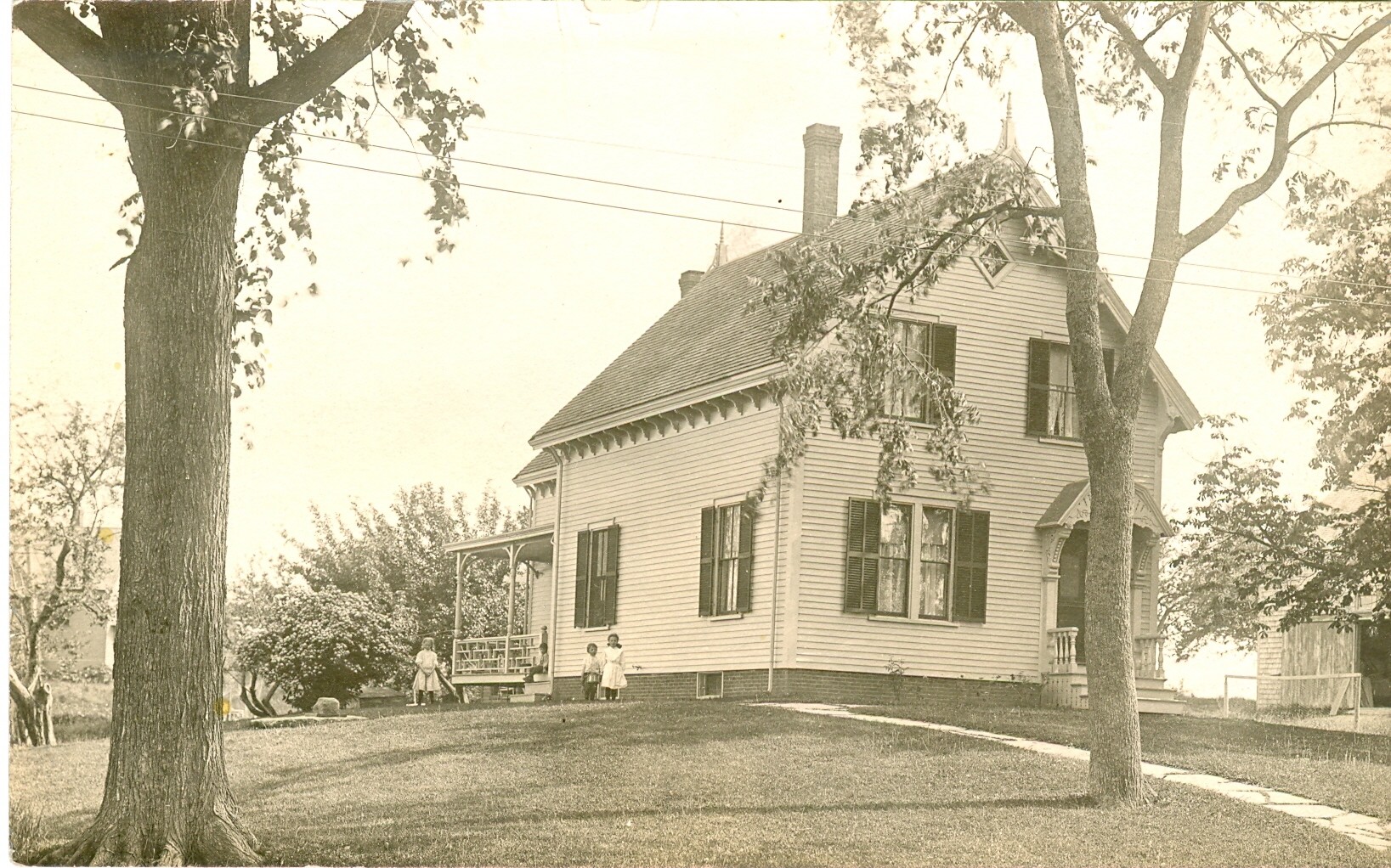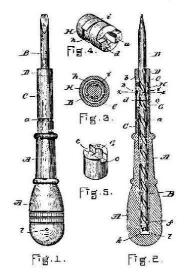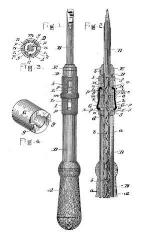
Fig. 1: Announcement in CARPENTRY & BUILDING magazine, October, 1883
This study is focused
on a series of spiral screwdrivers patented by Isaac Allard, F. A.
Howard,
and J. W. Jones and manufactured by the latter two of these men.
The earliest examples of
the racheting screwdrivers and the simplest (clockwise only) versions
of
the Archimedean screwdrivers begin to appear in tool catalogs and
related
literature in the late 1880s and the early 1890s (see Fig. 1). The
spiral
screwdrivers with a provision for some sort of mechanical release on
the
return stroke, with a reversing feature and with a racheting feature in
combination with the mechanical release begin to show up about ten
years
later.

Fig. 1: Announcement in CARPENTRY & BUILDING magazine, October, 1883
The earliest documentation for a spiral screwdriver offered for sale, which I have been able to locate, is a notice in the "Novelties" section of the October, 1883 CARPENTRY AND BUILDING announcing the availability of the Allard Spiral Screwdriver manufactured by F. A. Howard of Belfast, Maine. Although there are earlier patents for some screwdriver features such as ratchets, the 1868 Allard patent is the earliest I have been able to find for a spiral screwdriver.
The quaint discourse on
spiral
screwdrivers in the 1895 & 1897 CHARLES A. STRELINGER catalogs
mentions
that the company had received requests for spiral screwdrivers as early
as 1877. The inquiries came from persons who had seen such tools and
wanted
to know where they could be procured. After investigation, the
Strelinger
Co. concluded that the tool sought was the "Allard", which they
subsequently
began to carry in stock. Since they mention that their first observance
of one of these tools was from a "newcomer from the East," and that a
company
of their significant size had difficulty obtaining even a sample, it
might
be concluded that the tool was not marketed initially through normal
commercial
channels. Indeed, the above 1883 notice states that they are available
not only through the "hardware trade" but by mail from the
manufacturer.
The excerpt from the Strelinger catalog follows:
SPIRAL SCREW DRIVERS This article is intended not so much as a history of Spiral Screw Drivers, but as a history of our experience with Spiral Screw Drivers. At different times during the years 1877 and 1878 we had a number of calls for a screw driver that operated by pushing. The inquirers had heard of it, and an occasional inquirer stated that he had seen one, but we could in no conceivable way locate one of these drivers, or obtain a sample, and we had about come to the conclusion that the Spiral Screw Driver was a "Will o' the Wisp" (a sort of fairy tale as it were), and existed only in the imaginations of the inquirers, when one day a cabinet-maker employed by the Pullman Car Co. came into our store, and incidentally informed us that one of his shopmates, a newcomer from the East, had one of these drivers. At some little pains and expense we secured this driver, and were thus enabled to get the name and address of the manufacturers. It was the Allard Spiral Screw Driver and quite similar in design and construction to the present style. The price at that time being $3.00 each. Two or three years later the supply ceased. The only reason we could learn was that the demand had grown so, that the maker was unable to supply it, on account of insufficient machinery, and so had stopped making them entirely in order to build more machinery. We always thought this was a very queer proceeding, but, at any rate, other styles were brought out from time to time, and this class of screw driver is almost as well known - if not quite as commonly used - as the ordinary style.The Spiral Screw Driver ranks among the most wonderful labor-saving tools ever invented, and this method of driving small and medium sized screws is an entire revolution. It saves fully two thirds of the time, as it will drive screws in either soft or hard wood in one-third of the time taken by an ordinary screw driver. It is operated by simply pushing on the handle.
CAUTION: BE SURE AND OIL OFTEN. THERE IS GREAT FRICTION, AND THE TOOL WILL LAST TWICE AS LONG IF PROPERLY OILED.
In the past ten or fifteen years we handled eighteen different makes of Spiral Screw Drivers, including thirty-two different sizes and styles. Among them the Allard, Baush, Rapid, Ellrich, Forest City, Eureka, Eclipse, Electric, Goodell, Howard-Allard, Jones, Haberle, Mueller, Millers Falls, Prior's, Reed's, Shaver and Wright.
At the time of compiling this catalog we had in stock eleven of the foregoing makes and styles (the other six having been discarded on account of their having no special merit). In order to avoid multiplicity and confusion we found it necessary to cut down this line, retaining only such as were, in our judgment, the best in their respective classes. As all of the eleven styles had more or less merit, it was not altogether an easy matter to decide which should be kept, and so every point had to be gone over and considered carefully.
Without going into details too much,and perhaps for the reason of demonstrating how thoroughly all the various tools in this catalogue have been considered, we may explain why two or three well known Spiral Drivers are not shown here. The Forest City Spiral Screw Driver is altogether the most ingenious and complete tool in this line that we have ever seen. It has more motions than any other, and many improvements, but the mechanism is rather complex. The chuck for holding the bits is insufficient, and we do not believe that it has either the strength or wearing qualities of the others.
The Mueller Driver is a strong, practical tool, well made, but for the work for which a Spiral Screw Driver is best adapted, we think it is too heavy.
There have been four improvements since the Allard was first perfected. First, the chuck or holder by which the tools could be changed, so that different sizes of bits could be used. Second, the right and left spiral (see Fig. 3448), so that the tool could be run either hand. Third, the loose collar (see Fig. 3447), which remains stationary while the shaft revolves; and Fourth, the continuous motion in one direction. There is but one driver that contains all of these points -- the Forest City -- and this, for reasons stated above, we felt obliged to leave out. The No. 22 (Fig. 3448) contains the three points first named.
TO SUM UP - We believe that the line of Spiral Screw Drivers shown here embraces all the best qualities which can possibly be found in this class of tools.
The original patentee,
Isaac Allard (1822-1884) began work as a watchmaker in 1840. Business
directory
listings for Allard for the years 1849-1882 indicate that in addition
to
first being listed as "watchmaker and repairer", he moved on to being
listed
as "notary, machinist, jeweler, silver and silver plate dealer, fancy
goods
dealer". One might speculate that his "upward mobility" might have had
something to do with his marrying the daughter of the machinist,
watchmaker
and "fancy goods dealer" to whom he apprenticed.
It is doubtful if this original version was actually manufactured; I am not aware of any examples. Catalogs from the 1880s show illustrations identified in one instance as the "Allard's Patent" model and in another with the generic designation - "The Spiral Screwdriver." The appearance of these, however, more closely resembles the 1874 Allard patent and the examples in Fig. 1 and Fig 4.
Fig. 2: 1868 Allard patent illustration.
The force of the spring when released is intended to drive the screw.

Mr. Howard's 1893 house still stands in obviously well maintained condition on Belmont Street in Belfast.
Fig. 3: 1874 Allard patent illustration.
Note the reduced diameter of the shaft for holding the bit against
the screw; this was replaced by a free collar on some of the later
models.

Fig. 4: Example #1 (c.1874-1892)
signed: F. A. Howard / - Maker - / Belfast, Me.Allard's Pat. / Aug.
4 1868 / Nov. 24 1874
It should be noted that both the above patents predate significantly the 1882 A. H. Reid patent for his bit stock - advertised as the "Lightning Brace" but in reality a screwdriver - of which we see so many examples. Even by 1882 the Reid model did not incorporate any mechanical means for releasing the shaft on the return stroke but instead relied upon the driving hand shifting to the inner, free-wheeling handle.
To gain some perspective
on the place of Allard/Howard/Jones, consider a few other patents for
spiral
screwdrivers and their patent dates - the well known Decatur Coffin
Co./Eureka/C.
H. Olson (1884), J. R. Doolittle (1886), H. Mueller (1889), A. D. &
H. E. Goodell (1890), G. E. Gay & J. H. Parsons (1892) and Zachary
Furbish assigned to North Brothers (1895). The one patent which comes
closest
in date, is that of William Hofer, New Haven, Connecticut (1869) for a
model which very closely resembles the 1884 C. H. Olson.

Fig. 5: 1892 Howard patent illustration.
Improvements added are a friction spring for the clutch and a spindle
lock in the closed position

Fig. 6: Example #2 (c.1892-1894)
signed: F. A. Howard / - Maker - /Belfast, Me. / Pat. Aug 4 1868 /
Nov 24 1874 / Mar 1 1892
The indefinite engagement of the clutch and nut was apparently found to be a problem in the examples in Fig. 4 (example 1) & Fig. 6 (example 2) when held with the bit pointed downward. In this position gravity would pull the clutch nut toward the bit and away from the clutch. This shortcoming prompted the need for some means of ensuring consistent engagement of the clutch and prompted the introduction of an expanding spring surrounding the clutch nut exerting friction to prevent it from dropping. Strangely however, the latter example, even though showing the 1892 patent date, does not include the friction spring.
The other significant addition in this improved patent was a notch in the rear end of the spindle which engaged with a crosswise pin in the handle to provide a positive lock for the shaft and thus prevent the shaft from rotating and forcing the handle out when turned counterclockwise for screw removal.
This example (Fig. 6 -
example
2) must be considered earlier than Fig. 7 (example 3) & Fig. 8
(example
4) because it does not include the "son" in the name.

Fig. 7: Example #3 (c. 1895-1901)
signed: Made by / F. A. Howard & Son / Belfast, Me / U.S.A/ Pat.
Mar 1 1892
The friction spring to insure engagement of the clutch is included in the examples pictured in Fig. 7 (example 3) & Fig. 8 (example 4).
Although the one-piece, non-removable bit in Fig.
8 (example 4) would appear to come chronologically before the removable
bit models shown in Fig. 6 (example 2) and Fig. 7 (example 3), it must
be placed later because of the inclusion of "Son" in the name.

Fig. 8: Example #4 (c. 1895-1901)
signed: Made by / F. A. Howard & Son / Belfast, Me / U.S.A. / Pat.
Mar 1 1892
Examples 3 & 4 are signed the same and apparently fall into the same time period of manufacture. Two characteristics set example 4 apart from the others: (1) It was manufactured without the removable bit which all the other models except the earliest include. (2) It was manufactured with only 2 spiral grooves in contrast to the 4 spiral grooves on all the other uni-directional models.
These two characteristics
seem to argue that this model was the low priced, "competitive" model,
whereas example 4 was the then standard model, with the improvement of
the addition of a free turning ring/grip behind the bit chuck to aid in
guiding the bit and holding it in place for the withdrawal stroke.
These
two models (examples 3 & 4) are not illustrated or listed in any of
the catalogs and related literature studied.
It is curious to note that this patent by J. W. Jones for the earliest reversing spiral screwdriver and the above patent by F. A. Howard for improvements in the uni-directional spiral screwdriver were both granted on the same date; furthermore, each of these inventors served as a witness to the other's patent description (not included here).
Only the scant information of a Belfast directory listing as "machinist" has been found for J. W. Jones. Since his name does not appear on the tool even after his patents were granted it will have to be assumed that he was an employee of F. A. Howard.
For comparison it can be
noted that the North Brothers patent for the reversing feature (double
spiral on the same shaft) was granted in 1895 and the Goodell patent
with
the reversing feature (right hand spiral telescoping into the left hand
spiral) was granted in 1897 and both were probably not offered for sale
until about 1898.

Fig. 9: 1892 J. W. Jones patent illustration.
First model with reversible feature.

Fig. 10: Example 5 (c. 1892-1895)
signed: F. A. Howard / - Maker - / Belfast, Me. / Jones' Pat. / Mar
1 1892

Fig. 11: J. W. Jones 1895 patent illustration.
Jones' Improved Reversible Model

Fig. 12: Example 6 (c.1895-1901)
signed: Made by / F. A. Howard & Son / Belfast, Me U.S.A. / Pat'd
July 23 95

Fig. 13: Left: Goodell Pratt chuck nut; Right: Howard/Jones chuck
nut)
Note similarity of chuck nut on Goodell Pratt and Howard/Jones
screwdrivers.
The style of the
cartouche
(Fig. 14) with inward rounded corners used for the signature and patent
information begun by Howard was continued in the same style through all
of the examples studied here.

Fig. 14: Style of Allard/Howard/Jones markings
I have the feeling that
many
of the features of the Allard/Howard/Jones screwdrivers are in some way
carried on in those later manufactured by the firms of Goodell
Brothers,
Goodell Pratt and Millers Falls. The similarity of the chuck nut and
the
removable bit on many of the screwdrivers manufactured by these firms
to
the style used by Howard and Jones are too striking to be coincidental.
I have been unable, at this time, to document a link with any of the
above
three firms. It is my hope that, in time, this hypothesis can be proven
and documented.
Belfast Museum, Inc., Andrew Kuby, Curator
Maine State Museum, Brian M. Sipe, Curator of Decorative Arts
Carpentry & Building, New York, David Williams Company,
October
1883
WOODWORKERS TOOLS, Detroit, Charles A. Strelinger & Co.,
Detroit, 1895
WOODWORKERS TOOLS, Detroit, Charles A. Strelinger & Co.,
1897 - reprinted by Mid-West Tool Collectors Association, 1979
Belfast and Camden Directory, Ayer, Mass., E. B. Butterfield,
1890
Vital Records of Belfast, Maine, Portland, Maine Historical
Society, 1919
1849 Mercantile Union Business Directory Part I - Maine, New
York, Pratt & Co., 1849
1855 Maine Business Directory, Boston, George Adams, 1855
Maine Register, State Year-Book and Legislative Manual,
Portland,
G. M. Donham, 1893
Williamson, Joseph, History of the City of Belfast in the State
of Maine, Vol. II, Houghton Mifflin Company, Boston & New York,
1913
WOODWORKERS' TOOLS, Philadelphia, Wm. P. Walters, 1888
Republican Journal, (Belfast, Maine), October 1, 1903 (obituary
- F. A. Howard)
Return to Spiral Screwdriver Home Page
©1992 Clifford D. Fales All Rights Reserved